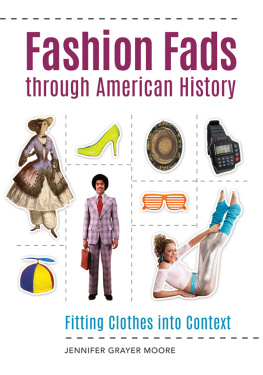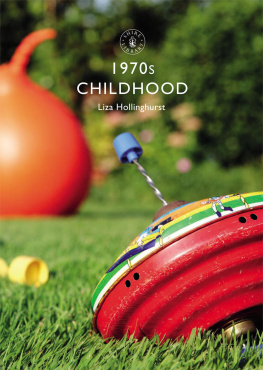
About this Book
Groovy FASHION and FUNKY FADS!
In the 1970s, if you had curly hair, you could sport an Afro. If you had straight hair, you could wear Dorothy Hamills wedge cut or Farrah Fawcetts feathery flip. Both men and women disco-danced in bell-bottoms and platform shoes. However, equality in the fashion world was not enough. The Womens Liberation Movement wanted women to have the same opportunities in business and education that men had. Read about the fashions, fads, pop culture icons, and world events of the 1970s!
About the Author
Felicia Lowenstein Niven is a professional freelance author who enjoys writing for young people. She has been published in many magazines and also has a teaching degree for grades K-8.

CONTENTS
Cover
About this Book
Title Page
Introduction: Wild and Crazy Fads
Chapter 1: Hairstyles
Farrah Fawcetts Feathers
Dorothy Hamills Wedge
The Afro
The Shag
Chapter 2: Womens Styles and Fashion
Wrap It Around
Mini, Midi, and Maxi
Top It Off
Jeans by Design
Chapter 3: Mens Styles and Fashion
Not Too Cheesy!
The New Play Suit
Sportswear
Crazy for Caftans
Chapter 4: Accessories
Plenty of Puka
In the Mood
F Is for Friendship Bracelet
A Step Up
Down to Earth
Chapter 5: Fads and Trends
Denim, Denim, and More Denim
Disco Fever
The Peasant Look
The Nonstyle: Punk
Chapter 6: Pop Culture
Pet RocksYes, Rocks!
Disco Dancing
Workout Time
The Womens Movement
Timeline
Glossary
Further Reading
Books
Internet Addresses
Index
Note to Our Readers
Copyright
More Books from Enslow
The 1970s
Introduction
Wild and Crazy Fads

Image Credit: courtesy Everett Collection
Women who had naturally straight hair, like Maureen McCormick who played Marcia Brady on The Brady Bunch television show, didnt have to worry about ironing their hair to be in style!
An iron sure comes in handy for keeping your clothes looking neat. In the 1970s, it had another use. Women used to iron their hair straight. Back then, there were no straightening irons, but women had a choice: they could spend a lot of money and get straight hair in a salon, or they could straighten their hair at home with an iron. It seemed dangerous, but many women did it. The woman would lay her hair on the ironing board. A friend or family member would iron her hair bit by bit very carefully. An iron that was too hot could damage the hair. It also could burn the woman or the person ironing! Todays straightening irons take much of the danger out of this crazy process!
Straight hair may have been in style for women, but curly hair was in style for men. Some men went to beauty salons for perms. That may sound odd, but mens fashion had already gotten more like womens fashion; now mens hair did, too.

Image Credit: Shutterstock
Men began to wear jewelry, too. Gold chains were popular and so were peace-sign necklaces. Cool watches lit up; some could even play music! Most of mens jewelry during this time was unisex. It could be worn by a man or a woman.
As it turned out, so could mens clothes. The movie Annie Hall showed a woman in a mans suit. The oversized mans jacket and pants created a tomboyish look for the lead actress, Diane Keaton. The style caught on; many women copied it by taking mens clothes and making them their own.

Image Credit: ClassicStock/Alamy
A young man dressed in typical seventies clothing accented by a necklace
After all, the seventies were all about individuals. In fact, it was
even nicknamed the me decade. People were into individual successes. They pursued individual happiness. So women could dress like men. Or they could dress like women.
Some women liked to show off their femininity, and legs, with another fashion choicehot pants. Hot pants were really short shorts. The style was similar to silky underwear in the 1920s. They were known as tap pants. In the 1970s, they were made for regular street wear. Hot pants were made from materials such as velvet, cotton, nylon, and denim. They came in solid colors and patterns.

Image Credit: CSU Archives/Everett Collection
Hot pants look flirty and fun with a pair of lace-up sandals!
Hot pants were a style that did not last. But other styles from the seventies did. Read on to find out more.
Chapter 1
Hairstyles
After years of fussing with hair, it was time to look natural. The seventies hairstyles were simple and did not require a lot of work. There was no more teasing hair to the highest heights or sleeping in curlers to get that extra volume. People could literally let their hair down.
Straight hair was one of the most popular styles. It was easy for people with naturally straight hair. They could wear their hair parted down the middle and long. If they didnt have straight hair, but they wanted it, they could get it straightened in a salon; or they could try the iron trick in the previous pages. (Note: Do not try that at home!)

Image Credit: Shutterstock
People with tightly curled hair could wear an Afro. This style created a puff of hair around the head and was very easy to maintain. Afros were worn by men and women in the seventies.
Mullets were another popular hairstyle. The cut was short in the front and long in the back. Although more popular with men, mullets were worn by women. If you didnt like the mullet, you might like the shag. This heavily layered haircut created a shaggy or slightly messy look. Looking for a cleaner look? Try the wedge cut. This short hairstyle was worn by women, including figure skater Dorothy Hamill.
Men also wore a style that hadnt been seen in years. They wore sideburns and beards. This became a very fashionable look.
In the 1970s, handheld blow-dryers were common. Men and women owned and used them. That gave way to many blow-dried styles, such as the feathered cut, which was a layered look that resembled feathers.
Farrah Fawcetts Feathers
Farrah Fawcett was a familiar face in the 1970s. She was as well-known for her hair as she was for her TV shows. She made the feathered look famous. This hairstyle was also known as the flip. Her long blond hair was layered along the sides. A blow-dryer was used to curve it back. The look was natural. It looked a little bit like feathers along the sides. Everyone wanted to have the Farrah cut. Both men and women wore feathered bangs and cuts.
Next page



















